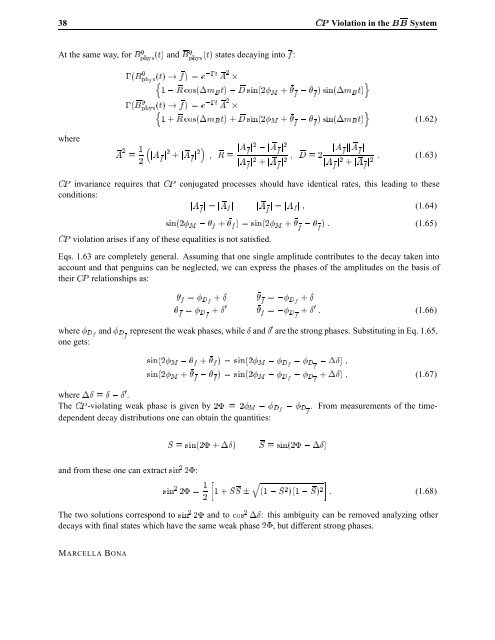Violation in Mixing
Violation in Mixing
Violation in Mixing
You also want an ePaper? Increase the reach of your titles
YUMPU automatically turns print PDFs into web optimized ePapers that Google loves.
38 �È <strong>Violation</strong> <strong>in</strong> the �� System<br />
At the same way, for � Ô�Ý× Ø and � Ô�Ý× Ø states decay<strong>in</strong>g <strong>in</strong>to �:<br />
where<br />
� �<br />
�Ô�Ý× Ø � � � � Ø � ¢<br />
Ò Ó<br />
Ê Ó× ¡Ñ�Ø � ×�Ò �Å � � ×�Ò ¡Ñ�Ø<br />
� �<br />
�Ô�Ý× Ø � � � � Ø Ò<br />
� ¢<br />
Ó<br />
Ê Ó× ¡Ñ�Ø �×�Ò �Å �� �� ×�Ò ¡Ñ�Ø<br />
� ��� � �� � �<br />
� � Ê � �� � � �� � �<br />
�� � � �� � �<br />
� ��<br />
�� � ��� � �<br />
�� � � �� � �<br />
(1.62)<br />
� (1.63)<br />
�È <strong>in</strong>variance requires that �È conjugated processes should have identical rates, this lead<strong>in</strong>g to these<br />
conditions:<br />
�� � � � ��� � �� � � � ��� � � (1.64)<br />
�È violation arises if any of these equalities is not satisfied.<br />
×�Ò �Å �� �� � ×�Ò �Å � � � � � (1.65)<br />
Eqs. 1.63 are completely general. Assum<strong>in</strong>g that one s<strong>in</strong>gle amplitude contributes to the decay taken <strong>in</strong>to<br />
account and that pengu<strong>in</strong>s can be neglected, we can express the phases of the amplitudes on the basis of<br />
their �È relationships as:<br />
�� � ��� Æ � � � ��� Æ<br />
� � � �� �<br />
Æ �� � �� �<br />
Æ � (1.66)<br />
where ��� and �� � represent the weak phases, while Æ and Æ are the strong phases. Substitut<strong>in</strong>g <strong>in</strong> Eq. 1.65,<br />
one gets:<br />
×�Ò �Å �� �� � ×�Ò �Å ��� �� � ¡Æ �<br />
×�Ò �Å � � � � � ×�Ò �Å ��� �� � ¡Æ � (1.67)<br />
where ¡Æ � Æ Æ .<br />
The �È -violat<strong>in</strong>g weak phase is given by ¨ � �Å ��� �� � . From measurements of the timedependent<br />
decay distributions one can obta<strong>in</strong> the quantities:<br />
and from these one can extract ×�Ò ¨:<br />
Ë � ×�Ò ¨ ¡Æ Ë � ×�Ò ¨ ¡Æ<br />
×�Ò ¨ �<br />
�<br />
Õ<br />
Ë˦ Ë Ë<br />
� � (1.68)<br />
The two solutions correspond to ×�Ò ¨ and to Ó× ¡Æ: this ambiguity can be removed analyz<strong>in</strong>g other<br />
decays with f<strong>in</strong>al states which have the same weak phase ¨, but different strong phases.<br />
MARCELLA BONA















